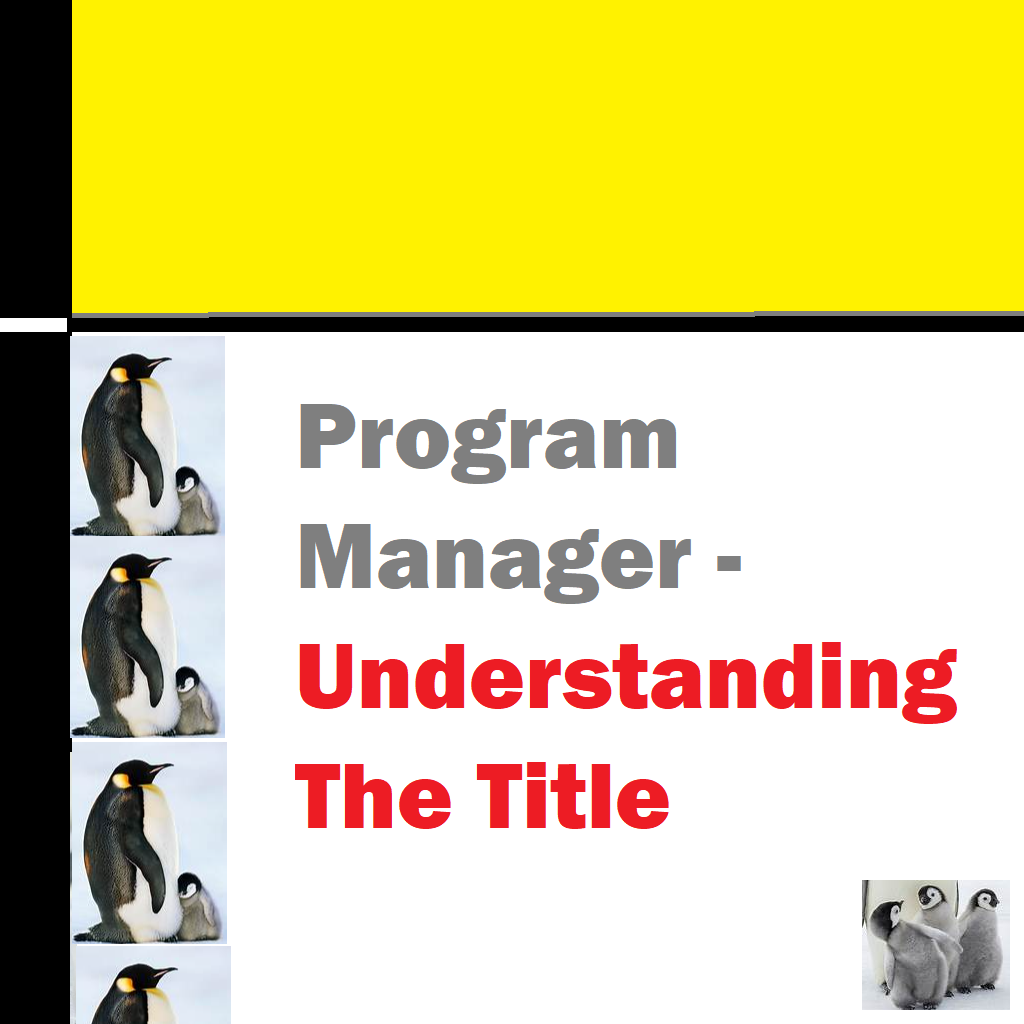Program management and the role of a program manager have evolved significantly over time, driven by the complexity of projects and the need for effective coordination and delivery. The history of program management can be traced back to the mid-20th century when large-scale projects, especially in the aerospace and defense industries, necessitated a more comprehensive approach to managing interconnected initiatives.
In the early days, project management primarily focused on managing individual projects with defined scopes and clear objectives. However, as organizations started to undertake multiple, interdependent projects simultaneously, it became evident that a more holistic approach was needed to ensure successful outcomes. This realization led to the emergence of program management as a discipline. In the 1960s and 1970s, the United States Department of Defense (DoD) played a significant role in shaping the concept of program management. With the development of complex weapons systems and space exploration projects, the DoD recognized the importance of managing clusters of related projects together to achieve broader strategic goals. This prompted the establishment of program management practices to oversee major defense programs like the Polaris missile and the Apollo space program.
During the 1980s and 1990s, the principles of program management started to spread beyond the defense sector and into other industries, including information technology, construction, and healthcare. Companies began adopting program management methodologies to better manage their portfolios of projects, ensuring they aligned with corporate objectives and were delivered efficiently.
In the early 21st century, as globalization and technological advancements accelerated, businesses faced even greater complexities in managing multiple projects simultaneously. This gave rise to the need for highly skilled program managers who could navigate intricate challenges, collaborate with diverse teams, and ensure seamless project integration.
Today, program management has become an integral part of organizational success across various sectors. Program managers are key figures responsible for overseeing the planning, execution, and delivery of interconnected projects that collectively contribute to the achievement of strategic objectives. Their roles and responsibilities encompass program planning, stakeholder management, resource allocation, risk management, performance monitoring, and communication, among others.
The discipline of program management continues to evolve as organizations grapple with ever-changing business landscapes and increasingly intricate projects. As companies seek to optimize resources, drive efficiency, and adapt to dynamic environments, program managers play a vital role in orchestrating these endeavors, ensuring alignment with business goals, and delivering value to stakeholders.
CONTENT
A Program Manager in software development is a key role responsible for overseeing the planning, execution, and delivery of multiple related projects within an organization. They act as a bridge between the business and technical teams, ensuring that projects align with the company’s strategic goals and objectives. Program Managers focus on the big picture and are responsible for coordinating the efforts of various teams and stakeholders to achieve successful outcomes.
Key Responsibilities
Here are some key responsibilities of a Program Manager in software development:
- Project Planning: They work with stakeholders to define project goals, scope, and deliverables. They create project plans, establish timelines, and allocate resources accordingly.
- Risk Management: Program Managers identify potential risks and issues that may arise during the course of the projects and develop strategies to mitigate them.
- Communication: They facilitate clear and effective communication between team members, project stakeholders, and executives, ensuring everyone is aware of project status, progress, and any changes.
- Resource Management: Program Managers manage resources, including personnel, budgets, and equipment, to ensure projects are adequately supported.
- Cross-Team Coordination: They collaborate with various teams, such as development, design, quality assurance, and product management, to ensure smooth project execution and alignment.
- Performance Monitoring: Program Managers track project performance metrics and use data to assess progress and make informed decisions.
- Conflict Resolution: They address conflicts and challenges that arise within project teams or between different teams to maintain a harmonious and productive work environment.
- Stakeholder Management: Program Managers engage with stakeholders to gather feedback, manage expectations, and ensure that the project’s objectives meet their requirements.
- Change Management: They handle changes to project scope, timeline, or resources and ensure that these changes are properly communicated and understood by all involved parties.
- Continuous Improvement: Program Managers analyze project outcomes and identify areas for improvement, implementing lessons learned for future projects.
The role of a Program Manager is crucial in ensuring that multiple projects work together seamlessly, meeting business goals and delivering value to customers. They must possess strong organizational, communication, and leadership skills, along with a deep understanding of software development processes and project management principles.
Additionally, the roles and responsibilities of a Program Manager can vary depending on the organization, the industry, and the specific projects they are overseeing. However, in general, a Program Manager is responsible for managing multiple related projects and ensuring their successful delivery. Here are some common roles and responsibilities of a Program Manager:
- Program Planning: Developing a high-level program plan that aligns with the organization’s strategic objectives. This includes defining program scope, objectives, deliverables, and success criteria.
- Stakeholder Management: Identifying and engaging with key stakeholders, including executives, project sponsors, team members, and external partners. Effectively communicating with stakeholders to manage expectations and gather requirements.
- Resource Management: Allocating and managing resources such as budget, personnel, and equipment across multiple projects to ensure they are adequately supported.
- Project Coordination: Overseeing the planning and execution of individual projects within the program. Ensuring that project teams are aligned, tasks are assigned, and dependencies are managed.
- Risk Management: Identifying potential risks and issues across the program and individual projects. Developing risk mitigation strategies and contingency plans.
- Performance Monitoring: Tracking the progress of projects within the program, analyzing key performance indicators, and reporting on overall program performance to stakeholders.
- Quality Assurance: Ensuring that projects meet quality standards and align with best practices. Implementing processes to monitor and maintain the quality of deliverables.
- Change Management: Managing changes to the program scope, schedule, or resources. Assessing the impact of changes and communicating them to relevant stakeholders.
- Conflict Resolution: Addressing conflicts and challenges that arise within project teams or between different teams. Facilitating communication and collaboration to resolve issues.
- Program Governance: Establishing governance structures and processes to ensure proper decision-making and adherence to organizational policies and procedures.
- Continuous Improvement: Identifying areas for improvement within the program and implementing lessons learned from previous projects to enhance future performance.
- Communication: Facilitating clear and effective communication between team members, stakeholders, and executives to ensure everyone is informed about project status and progress.
- Strategic Alignment: Ensuring that the program remains aligned with the organization’s strategic goals throughout its lifecycle.
- Budget Management: Monitoring program budgets, identifying cost overruns, and taking corrective actions to stay within budget constraints.
- Program Closure: Overseeing the orderly closure of the program and ensuring that all deliverables are completed, lessons are documented, and knowledge is transferred to relevant parties.
In short, Program Managers play a critical role in orchestrating the successful delivery of multiple projects, ensuring alignment with business objectives, and providing the necessary support and coordination for project teams to achieve their goals. They must possess strong leadership, communication, and problem-solving skills, along with a deep understanding of project management principles and the industry they operate in.
Types of program management
Types of program management refer to various approaches or methodologies used to manage complex programs and their related projects. Each type has its characteristics, benefits, and applications. Here are some common types of program management:
- Traditional Program Management: This approach follows a structured, linear process where program managers create detailed plans, set milestones, and establish clear hierarchies for decision-making. It relies on predefined requirements and fixed scope, making it suitable for well-defined projects with predictable outcomes.
- Agile Program Management: Agile is a flexible and iterative approach that emphasizes adaptability and collaboration. It involves breaking down large programs into smaller, manageable chunks called iterations or sprints. The program manager and teams work closely together, delivering incremental value and continuously adjusting plans based on feedback and changing requirements.
- Hybrid Program Management: As the name suggests, this type combines elements of both traditional and agile program management. It allows program managers to adapt their approach based on the unique needs of the program, utilizing the best features of both methodologies to achieve successful outcomes.
- Change Program Management: This type of program management focuses on managing organizational change resulting from the implementation of new processes, technologies, or business strategies. Program managers work to ensure smooth transitions, address resistance to change, and maximize the benefits of the transformation.
- Benefits Realization Program Management: This approach emphasizes aligning program objectives with specific business benefits. Program managers track and measure the realization of these benefits over time, ensuring that the program’s efforts deliver the intended value to the organization.
- Crisis Program Management: When an organization faces critical challenges or unexpected disruptions, crisis program management comes into play. Program managers take swift actions to address the crisis, mitigate its impact, and stabilize the situation.
- Interdisciplinary Program Management: This type of program management deals with programs that involve multiple disciplines or industries. The program manager must facilitate collaboration among diverse teams and ensure effective communication and coordination.
- Mega Program Management: Mega programs are incredibly large and complex initiatives that often span multiple years and involve significant resources. Mega program management requires specialized skills to manage the scale and complexities involved in such projects.
- Strategic Program Management: Strategic program management focuses on programs that align with an organization’s long-term vision and strategic goals. The program manager ensures that the program’s outcomes contribute directly to the organization’s strategic success.
Each type of program management has its advantages and is suitable for specific contexts. Program managers must select the most appropriate approach based on the unique requirements, goals, and complexities of the program they are managing. Flexibility and the ability to adapt to different situations are valuable traits for program managers to excel in their roles.
Vision of a program manager
As a program manager, one of the most important responsibilities is to build a compelling vision for the team. The vision serves as a guiding light, inspiring and aligning team members towards a common purpose and shared goals. To create an effective vision, a program manager should consider the following steps:
- Understand Organizational Objectives: Before crafting the vision, the program manager must thoroughly understand the organization’s strategic objectives and long-term goals. This ensures that the team’s vision is in harmony with the overall direction of the company.
- Engage the Team: Involve team members in the vision-building process. Gather input and ideas from various stakeholders to ensure that the vision reflects the collective aspirations of the team. When team members feel included, they are more likely to embrace and contribute to the shared vision.
- Focus on Purpose and Impact: A strong vision should emphasize the purpose and impact of the team’s work. It should answer the question of why the team exists and the positive difference they aim to make in the organization and possibly beyond.
- Be Inspiring and Aspirational: The vision should be inspiring, painting a vivid picture of what success looks like. It should be aspirational, challenging the team to strive for excellence and reach beyond their current capabilities.
- Keep it Concise and Clear: Avoid jargon or complex language. A concise and clear vision statement is easier for the team to remember, internalize, and communicate to others.
- Align with Values: The vision should align with the team’s core values and principles. It creates a sense of purpose and identity that reinforces the team’s culture.
- Set Measurable Goals: While the vision is a broad, overarching statement, it should be accompanied by measurable goals and objectives. These specific targets provide a roadmap for the team to track progress and ensure they are moving in the right direction.
- Communicate and Reinforce: Once the vision is established, the program manager must continuously communicate it to the team. Regularly remind team members of the vision during meetings, updates, and any relevant discussions. Repetition helps reinforce the message and keeps the vision at the forefront of everyone’s minds.
- Adaptability and Flexibility: While the vision sets the long-term direction, a good program manager should remain open to feedback and be willing to adapt the vision if necessary. As circumstances change, the vision may need to evolve to stay relevant.
- Lead by Example: The program manager must embody the vision through their actions and decisions. Leading by example strengthens the team’s commitment to the vision and fosters trust and respect among team members.
In a nutshell, a program manager should build a vision that aligns with the organization’s objectives, inspires the team, and provides a clear sense of purpose and direction. By engaging the team in the process and consistently reinforcing the vision, the program manager can create a motivated and focused team capable of achieving extraordinary results.
Factors that can bring in success in program management
The success of a program depends on various factors, and a program manager should be aware of these critical elements to effectively plan, execute, and deliver the program. Here are some key factors that contribute to program success:
1. Clear Objectives and Vision: A well-defined and clearly communicated program vision and objectives are essential. The program manager should ensure that the team understands the purpose of the program, the expected outcomes, and how it aligns with the organization’s strategic goals.
2. Stakeholder Engagement: Effective stakeholder management is crucial. The program manager must identify and engage key stakeholders, including executives, sponsors, customers, and end-users. Understanding their expectations and concerns helps in managing expectations and obtaining necessary support throughout the program lifecycle.
3. Strong Leadership and Team: A capable and motivated team is fundamental to program success. The program manager should assemble a skilled and diverse team, foster a positive work environment, and provide strong leadership to inspire and guide the team towards achieving their goals.
4. Risk Management: Identifying, analyzing, and proactively managing risks is essential to avoid potential roadblocks. The program manager should have a robust risk management plan in place, with contingency measures to address unforeseen challenges.
5. Effective Communication: Open and transparent communication is vital in keeping all stakeholders informed about the program’s progress, challenges, and achievements. Regular status updates, progress reports, and feedback sessions help in building trust and managing expectations.
6. Resource Allocation: Proper allocation of resources, including budget, time, and personnel, is crucial for program success. The program manager should ensure that resources are available when needed and appropriately allocated across different aspects of the program.
7. Change Management: Programs often involve changes to existing processes, technologies, and organizational structures. The program manager should anticipate resistance to change and implement effective change management strategies to ensure smooth transitions.
8. Quality Management: Maintaining high-quality standards is essential for program success. The program manager should establish quality assurance processes and ensure that deliverables meet specified criteria.
9. Flexibility and Adaptability: The program manager should be prepared to handle uncertainties and evolving requirements. Flexibility and adaptability allow the program to adjust to changing circumstances and new information.
10. Performance Measurement: Defining key performance indicators (KPIs) and metrics to track progress is crucial. Regularly measuring and evaluating performance against these indicators allows the program manager to identify areas for improvement and take corrective actions as needed.
11. Lessons Learned: Continuously capturing and documenting lessons learned from the program’s experiences is vital. Reviewing successes and failures helps in improving future programs and projects.
12. Governance and Oversight: Establishing appropriate governance structures and providing clear oversight is essential for effective decision-making and ensuring compliance with organizational policies and standards.
By being aware of these factors and proactively addressing them, a program manager can enhance the chances of success and effectively navigate the challenges that arise throughout the program’s lifecycle.
Industry salary standards
The salary of a program manager can vary significantly based on various factors such as the industry, location, years of experience, the size and complexity of the programs managed, and the organization’s structure. Program managers typically hold senior-level positions, which often come with competitive compensation packages. In the United States, as of my last knowledge update in September 2021, the average annual salary for a program manager ranged from approximately $80,000 to $150,000 or more. However, it is essential to note that salaries can exceed this range for highly experienced program managers working in large corporations or industries with high demand for their expertise. In some cases, program managers can also receive additional benefits, such as bonuses, profit-sharing, stock options, and other incentives, which can further enhance their overall compensation package. The salary of a program manager in India can vary significantly depending on factors such as the location, company size, industry, years of experience, and educational background. On average, a program manager in India can expect a salary ranging from INR 8 lakhs to INR 25 lakhs per year.
Keep in mind that salary information can change over time due to factors such as economic conditions, industry trends, and company policies. Therefore, it is always best to consult up-to-date sources and salary surveys specific to your region and industry to get the most accurate and current information on program manager salaries.





